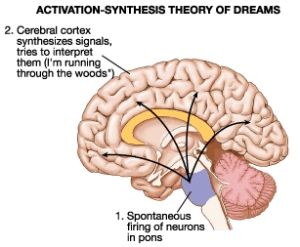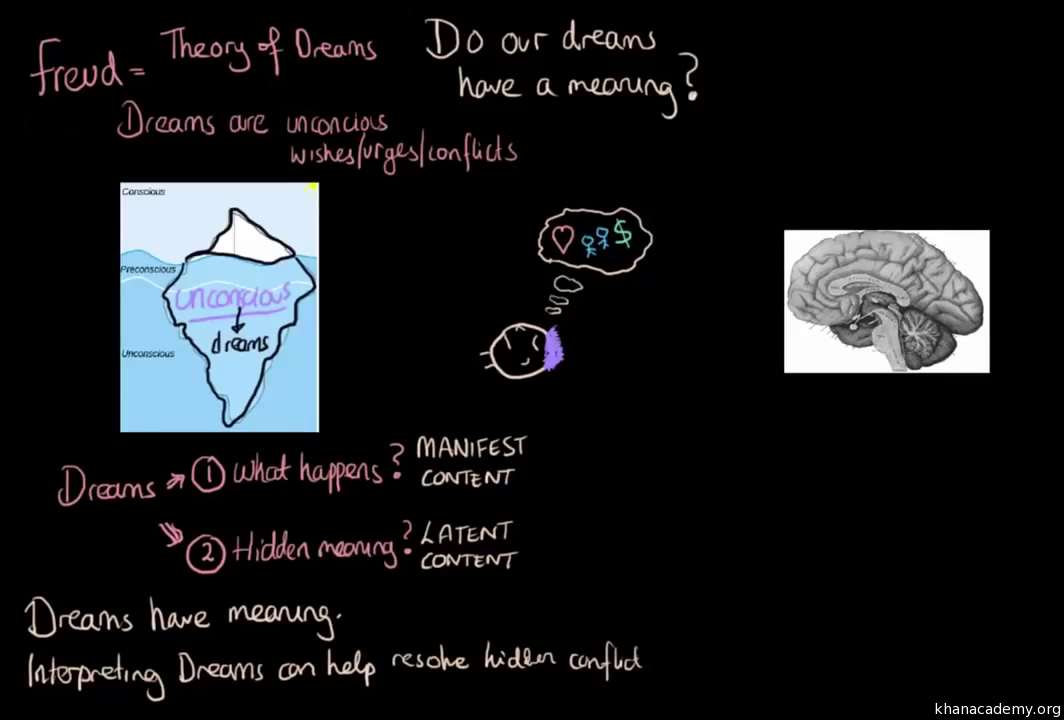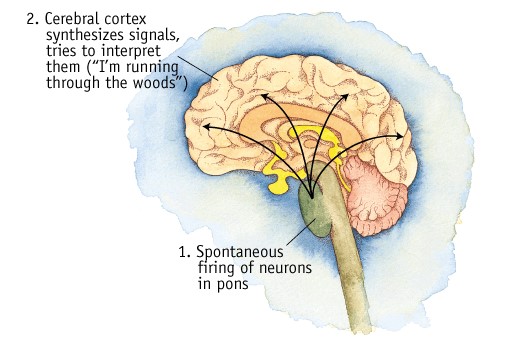How Does the Activation-synthesis Theory Describe the Purpose of Dreams
Freud believed that the unconscious id expresses itself in dreams as a way of resolving repressed or unwanted emotions experiences and aggressive impulses. A state of awareness consisting of the sensations thoughts and feelings that one is focused on at a given movement.

Learn About Theories Of Dreams And Activation Synthesis Model Chegg Com
They are only processing of brain system when we sleep.

. It is a question that scientists philosophers and clergy have attempted to solve for thousands of years. However given the vast documentation of the realistic aspects of human dreaming as well as indirect experimental evidence that other mammals such as cats also dream evolutionary psychologists have theorized that dreaming does indeed serve a purpose. In the activation-synthesis hypothesis dreams are a compilation of randomness that appear to the sleeping mind and are brought together in a meaningful way when we wake.
As suggested by its name its made up of two parts. Sometimes through dream they warn the dreamer about his dos and donts. Jung believed that dreams are a way of communicating with ones own unconscious.
The Activation Synthesis Dream Theory is an attempt to explain why it is that humans dream. Allen Hobson in 1977 different circuits in the brain become activated and that causes areas involved with emotions sensations and memories to become active during REM sleep. The activation-synthesis theory explains us that the messages of dreams are not a meaning.
By the time they reach the age of 7-8 the number of animal dreams is reduced to less than 30. In this sense dreams may provoke the dreamer to make new connections inspire useful ideas or have creative epiphanies in their waking lives. How does the activation-synthesis theory describe the purpose of dreams.
Robert McClarley and J. Once these circuits are activated during sleep areas of the limbic system involved in emotions and memories become active causing the brain to interpret these signals which results in dreaming. This is mostly the prescientific view which suggests Gods and Goddesses come in dream and predict the future to the dreamer.
The activation-synthesis hypothesis one prominent neurobiological explanation behind dreaming states that dreams hold no significance. How does the activation-synthesis theory describe the purpose of dreams. Then at the age of 15 fewer than 10 of dreams involve animals.
The Activation-Synthesis Theory. You just studied 36 terms. The activation-synthesis model of dreaming says that dreams are a meaningless by-product or epiphenomenon of sleep.
This chapter provides the most detailed critical analysis yet developed of the neurophysiological theory of dreaming called activation-synthesis theory a bottom-up theory that rejects a top-down neurocognitive approach because rigorous studies of dream content allegedly cannot be carried out especially on the basis of dream reports collected in the sleep lab. Children for example tend to have many dreams about animals when they are younger in age. Hobson argues that dreams are clumsy narratives stitched together by the forebrain to make sense of the activation of biochemical changes and erratic electric pulses originating in the brainstem.
Activation refers to the random firing of neurons from the brain stem. The theory that dreams result from the brains attempt to make sense of random of random neural signals that fire during sleep. So how does the activation synthesis hypothesis explain dreaming.
The continual-activation theory proposes that dreaming is a result of brain activation and synthesis. This is Hobsons theory of dream formation in a nutshell which he has updated many times over the last 30 years and is still referred to as the activation-synthesis hypothesis of. Dreams reflect the brains efforts to make sense out of neural activity that takes place during sleep.
Suggested back in 1977 this theory states that dreams are caused by activity in the brain. Freud believed dreams are short like fireworks. Dreams reflect the brains efforts to make sense out of neural activity that takes place during sleep.
They express those aspects of our personality we dont adequately develop in our waking life. They believe this brain activity especially during REM has some other purpose probably to do with brain restoration and protein synthesis see the. The chemicals in the brain transmit message from one nerve cell to another.
The theory essentially is quite basic and simple. The average college student experiences _____ nightmares a year. The expectation-fulfillment theory says that we use up emotional energy during the night.
Jung presented four theories on dreams. Allan Hobson were the psychologists who proposed this theory and they believed that during REM sleep brain circuits are activated and this causes the limbic system to become active. The most significant include.
According to this theory about dreams first proposed by Robert McClarley and J. This electrical energy randomly stimulates memories found in various area of the brain. The threat-simulation theory sees dreaming as an evolutionary practice ground for dealing with threats.
The theory claims that during REM sleep the brains neurons are firing in the lower brain centers which send information to the cortex or the part of the brain that makes sense of inputs during. Children at the age of 4 according to Halls work have 60 of their dreams involved animals. There are a number of assumptions that Sigmund Freud used to construct his dream theory.
_____ sleep is characterized by theta waves. His most popular idea is that most dreams have a compensatory function. Hobson McCarleys Activation-Synthesis Theory a Neurobiological Theory Hobson McCarley 1977 take the view that dreams are what happens when the mind tries to make sense of brain activity that occurs during sleep.
And the synthesis refers to the interpretation of these random signals into spontaneous thoughts by. Figure 1There are many theories about why we dream. The activation- synthesis model is another popular theory.
The activation-synthesis theory claims that dreams are meaningless interpretations of random firings of the brain. In the ancient world and even today in some cases dreams were considered having some supernatural significance. Under this theory dreams are an attempt by the brain to make sense of neural activity which occurs while people sleep.

Why Do We Dream Siowfa15 Science In Our World Certainty And Controversy

Dream Theories Freud Activation Synthesis Hypothesis Video Khan Academy

No comments for "How Does the Activation-synthesis Theory Describe the Purpose of Dreams"
Post a Comment